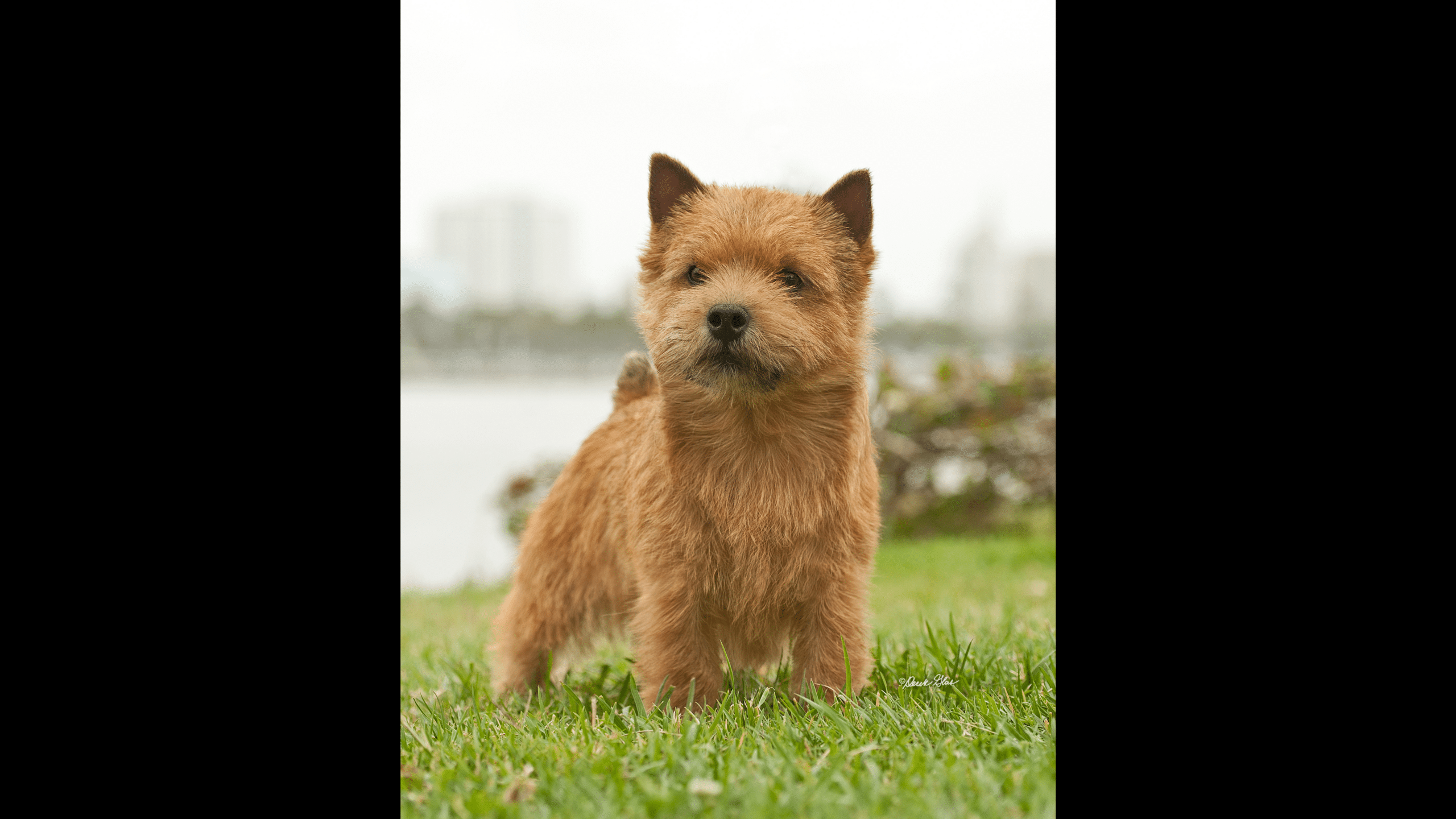
Home » Grooming the Norfolk & Norwich Terrier

This article was originally published in Showsight Magazine, April 2014 issue.
The first thing to consider when grooming a Norfolk or Norwich Terrier is the Breed Standard for each breed. The Norfolk and Norwich terrier standards differ in that the Norwich terriers body type is that of a Square dog and the Norfolk terrier body type is stated to be slightly longer than tall dog (of square). As stated in the AKC Norfolk Terrier standard: Length of back from point of withers to base of tail should be slightly longer than the height at the withers. The same reference to length from the AKC Norwich terrier standard: Length of back from point of withers to base of tail should be slightly longer than the height at the withers. The outline of the dog should be every groomers starting point. Throughout the grooming process one will mold the coat to fit the described outline for each breed. A dog in good coat is a sight to behold.
A dog in a blown or dead coat is often hard to evaluate without placing your hands on the dog. Grooming can both help and hurt the dogs’ chances in the show ring. The Norfolk and Norwich terrier standards state they should be shown in natural coat with minimal tidying (this is where we all chuckle) the standards state “a minimum of tidying is permissible but shaping should be heavily penalized”. Many of us spend hours each week doing “minimal tidying” to keep our dogs coat in show condition and looking its best. There are two ways people prepare their dogs coat for the show ring. The first method is most common and probably the easiest way for people without extensive grooming experience to manage a dogs’ coat. This grooming process is when the groomer pulls the dogs’ whole outer layer of hard coat off and just leaves the dog in its soft undercoat. After removing the whole hard coated outer layer they then tidy the furnishings and wait 12 weeks for the dog to grow a “show coat”.
This coat is a tight jacket but is only a single layer and will not last more than a month or so. The person showing this dog might get 6 weeks out of the coat before it starts to get too long and starts to open up (part down the back). When this happens they will have to pull the coat down and start all over again thus taking the dog out of the show ring for another 3 months. The second method is to “roll” the coat. This is where the coat is worked on a weekly basis. The groomer rolls a coat by taking the coat and pulling it up between their fingers and removes the longer, lighter colored hairs and leaves the intermediate length hairs. This is done all over the dog in an even manner to create an even appearance. This method allows the coat to grow in in layers. The layered coat can be kept going indefinitely and will allow the dog to be shown continuously. This is the preferred method of grooming for the Norfolk and Norwich but it takes considerable skill and patience to achieve a rolled coat. Once a dog is in a rolled coat it can be maintained by continuous pulling of the coat. It is important to note that you need to pull coat in order to get new coat to grow in. When examining a rolled coat one can really get an idea of the dogs true coat texture and an appreciation for its weatherproof characteristics. Norfolk and Norwich terriers should be shown in coats that appear to be all one length.
They should not have excessive skirting or puffy pants, they are not Scotties or Westies, or massive mutton chops on their faces. All of these things are extreme grooming techniques that detract from the natural appearance of the breeds. These dogs were bred to be working terriers they were bred to go to ground and to dig in the dirt. Profuse coat hanging off their body would not only be a disaster in the field but is often unattractive. A dog that is trimmed properly will accentuate the good points of the dog, a dog trimmed poorly can actually create a picture of the dog that is unbalanced or can create the appearance of faults that are not actually there. Norfolk and Norwich terriers should be trimmed to hide faults and highlight the positive attributes each dog has to offer. One of the biggest mistakes I see people make when grooming the Norfolk and Norwich terrier is that they leave too much hair on the elbows of the dog. This makes even a perfect front look bad. I have never met a dog that needed extra hair on its elbows. This area should be kept short. The next common mistake that people make to is over trim the head of their dog.
They remove too much hair from the top of the head and give the dog a fat skull. Both breed standards state the skull should be broad and slightly rounded with good width between the ears. Taking away too much hair detracts from the overall expression of these breeds. The hair on the corner of the eyes should be kept short. Leaving long hairs at the corner of the eyes makes the dog have a sad expression and not the “keen” expression as is called for in both standards. This method of trimming can also make a round eye appear even rounder again accentuating an improper eye shape for the breed. Grooming the topline is a topic we could write volumes about. The topline as stated in the standard for both of these breeds should be level. Now not every dog is born with a level topline. Toplines on Norfolk terriers seem to be stronger and straighter than the toplines the Norwich terrier thus easier to groom. When you have a topline that is not level you must create a level topline using the dogs’ hair. If the dog has a dip in the middle of their back a groomer must be careful not to remove too much hair from this area when trimming the dog. It is best if the groomer can grow layers in this area so there is always coat to fill in the dip. If the dog is high in the rear the groomer must keep the dogs coat short over the rump. Once the groomer has made the topline level they then must create a straight underline.
The underline of the dog (the area under the belly of the dog) is a reflection of the topline and adds to the overall outline of the dog. If the underline is not groomed evenly it will make the topline look uneven as well. The neck of the Norwich and Norfolk terrier is a “neck of medium length, strong and blending into well laid back shoulders” If the dog lacks length of neck a groomer must trim the front and sides of the dogs neck to create the illusion that the dog has a medium length of neck. The Norfolk and Norwich terrier should have feet that are round with thick pads. The feet should be trimmed underneath to remove all hair that would attract debris and distract from a round appearance. The outside of the foot should be trimmed round. The ears on the Norfolk and Norwich terrier should be stripped clean of hair. The Norfolk should have the hair in front of and underneath the ear pulled close to allow the ears to lay flat against the head of the dog. The Norwich terrier should have the top half of the ear cleaned both front and back and the remaining hair in front of the ear trimmed to lightly cover the ear opening.
The hair on the Norwich ear should have a fanned appearance when finished. The tail of both the Norfolk and Norwich terrier should be stripped close and the area around the rectum should be kept clean of hair as well. The rear end of the Norfolk and Norwich terrier should be broad with strong, muscular thighs. These dogs should have a rear end that extends past the base of their tail (a round rump appearance). When trimming this area it is important to tidy up the area but not to remove too much hair thus making the dog fall away behind or exposing the genitalia. Trimming these dogs for show can be a rewarding experience. The largest shortfall on grooming these breeds is when the groomer does not pull enough hair off the dog and they do not pull the coat often enough to create a rolled coat. The only way to perfect your grooming skills is to seek advice from people that have been trimming these breeds for years and have been very successful at it. I recommend looking at photos of top winning dogs and placing those photos in front of you when you trim your dog keep in mind those dogs probably had a fault or two themselves but the creative groomer has hidden them from sight with impeccable grooming. Another useful tip is to groom your dog in front of a mirror; this will allow the groomer to see what a person standing away from the dog would see. Most importantly do not be afraid to make a mistake… remember it is only hair and it will grow back!